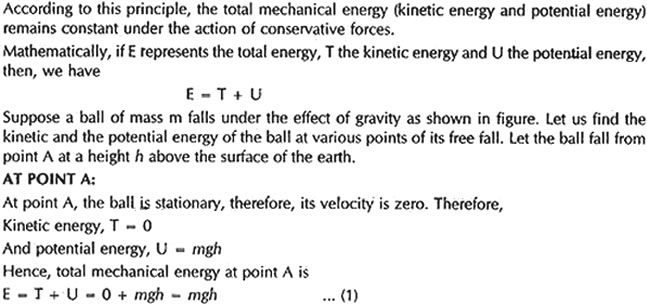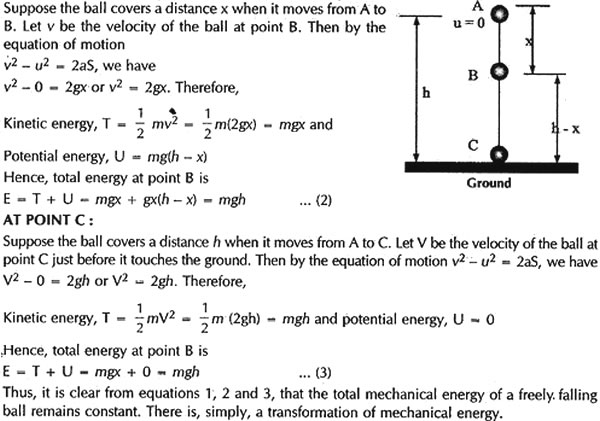Question: Calculate the electricity bill amount for a month of 31 days, if the following devices are used as specified:
- 3 bulbs of 40 W for 6 hours.
- 4 tubelights of 50 W for 8 hours,
- A TV of 120 W fro 6 hours.
Give the rate of electricity is Rs 2.50 per unit.
Answer:
- E1 = P × t = 0.04 × 6 × 3 = 0.72 kWh
- E2 = P × t = 0.05 × 8 × 4 = 1.60 kWh
- E3 = 0.12 × 6 = 0.72 kWh
Total E = 0.72 + 1.6 + 0.72 = 3.04 kWh.
Cost 31 days = Rate × E
= 3.04 × 2.50 × 31 = Rs. 235.60
Question: (a) What is meant by mechanical energy? State its two forms. State the law of conservation of energy. Give an example in which we observe a continuous change of one form of energy into another and vice-versa.
(b) Calculate the amount of work required to stop a car of 1000 kg moving with a speed of 72 km h”1.
Answer:
(a) It is the sum of KE and PE of an object. It states that energy can neither be created nor be destroyed. We observe a continuous change in energy in a simple pendulum and its explanation. At the mean position, the energy is wholly kinetic while at the extreme position it is wholly potential. As the pendulum oscillates its energy continuously changes between kinetic and potential.
Question: State the law of conservation of energy? Show that when a body falls from a certain height the total mechanical energy remains conserved.
Answer:
AT POINT B :
Question:
- Derive an expression for kinetic energy of a body having mass m and moving with a velocity v.
- When velocity of a body is increased 5 times, what is the change in its kinetic energy?
- Two masses m and 2m are dropped from heights h and 2h. On reaching the ground, which will have greater kinetic energy and why?
Answer:
- For derivation see above questions.
- Kinetic energy is given by the expression
KE = 1/2 mv2, therefore, if velocity is made 5 times KE will increase by 25 times. - More the potential energy more will be the kinetic energy of the body when it falls. Hence, the body with mass 2m will have greater kinetic energy as it has more potential energy.
Question:
- State the law of conservation of energy.
- What is the work done to increase the velocity of a car from 36 km h-1 to 72 km h~1 if the mass of the car is 1500 kg? Does the work done by the force have a negative or a positive magnitude?
- Where does an oscillating pendulum have maximum PE and KE?
Answer:
Question: A light body and a heavy body have the same kinetic energy. Which one will have the greater momentum?
Answer: As p = √2mK. Since K is the same for both the bodies, p ∞ √m i.e., the heavier body has more momentum than the lighter body.
 Class Notes NCERT Solutions for CBSE Students
Class Notes NCERT Solutions for CBSE Students









